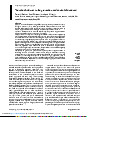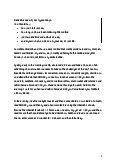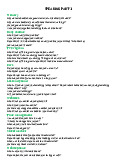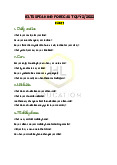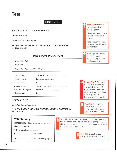



















Preview text:
Chapter 8: Performance management 1
Shown below is a diagram of a simple control cycle. What should be in the box marked 'X'? Measure Resources Operations outputs Control action Monitor X and control A Feedback B Fixed costs C Activity levels D Budgets and standards LO 3a 2
Which of the following is not a feature of effective feedback reports? A
Made available in a timely fashion B Produced on a regular basis C
Distributed to as many managers as possible D
Sufficiently accurate for the purpose intended LO 3a 3
Which of the following describes exception reporting? A
Reporting of exceptional activities within an organisation B
Reporting only controllable matters to managers C
Reporting only of variances which exceed a certain value D
Reporting of all variances to the relevant manager LO 3a 4
Which two of the following statements about management control reports are correct? A
Reports should be completely accurate. B
Reports should be clear and comprehensive. C
Reports should not include information about uncontrollable items. D
Based on the information contained in reports, managers may decide to do nothing. LO 3a ICAEW 2019
Chapter 8: Performance management 91 5
Which of the following is not an example of budget bias? A
A manager overestimates costs when setting the budget, to guard against
overspending during the period. B
A manager's advertising budget is disproportionately large in comparison with the
budgeted revenue to be generated. C
A manager underestimates revenues when setting the budget to ensure that the
budget target can be easily exceeded. D
A manager overestimates revenues when setting the budget in order to make a
favourable impression on senior managers. LO 3a 6
Which of the following statements is correct? A
Since management accounts are prepared for a different purpose from that of external
financial reports, there is no need for any convergence between the two. B
The setting of appropriate performance measures will ensure that an organisation's
performance management is effective. C
Since the board of directors is not concerned with the day to day management of a
business they do not require regular management reports. D
Management control activity might involve a comparison of the latest forecast results with the original budget. LO 3a 7
Which of the following is not a style of performance evaluation identified in Hopwood's studies? A Budget constrained B Non-accounting C Revenue focused D Profit conscious LO 3a 8
Select which of the following styles of using budgetary information is most likely to lead to
each of the situations described.
Job related tension is caused by which of the following styles: A Budget constrained B Profit conscious C Non-accounting
Less focus on cost control is caused by which of the following styles: D Budget constrained E Profit conscious F Non-accounting 9 2
Management Information: Question Bank ICAEW 2019
Incidence of budget bias is caused by which of the following styles: G Budget constrained H Profit conscious I Non-accounting LO 3a 9
A company have recently implemented a new budgetary planning and control system after several years of trading.
Having made a significant investment in the new system, the company's management team
were surprised to learn that it is not designed to do which of the following? A
Improve control of actual performance B
Improve coordination of activities C Improve gross profit D
Improve communication of ideas and plans LO 3a
10 Which of the following is a reason for adopting a decentralised rather than a centralised organisational structure? A
Improved goal congruence between the goals of divisional management and the goals of the organisation B
Rapid management response to changes in the trading environment C
Availability of objective performance measures D
Improved communication of information between the group's managers LO 3a
11 Division P is an investment centre within PC Ltd. Over which of the following is the manager
of division P likely to have control? (1) Transfer prices
(2) Level of inventory in the division
(3) Discretionary fixed costs incurred in the division
(4) Apportioned head office costs A (1), (2), (3) and (4) B (1), (2) and (3) only C (1) and (2) only D (1) only LO 3b ICAEW 2019
Chapter 8: Performance management 93
12 The manager of a trading division has complete autonomy regarding the purchase and use
of non-current assets. The division operates its own credit control policy in respect of its
customers but the group operates a central purchasing function through which the division
places all orders with suppliers and invoices are paid by head office.
Inventories of goods for sale are kept in central stores, from which local divisions call off
requirements for local sales on a monthly basis into a local inventory.
Divisional performance is assessed on the basis of controllable residual income. The
company requires a rate of return of 'R'. Using the following symbols: Divisional non-current assets N
Apportioned net book value of central stores S Divisional working capital Receivables D Local inventory I Bank B Payables (P) W Divisional net assets T Divisional contribution C Controllable fixed costs (F) Head office charges (H) Divisional net income G
Which of the following formulae calculates the division's controllable residual income? A [C – F] – [(N + D + B) R] B
[C – F] – [(N + D + I + B) R] C C – [(N + D) R] D G – (T R) LO 3b
13 Division D of Distan Ltd is considering a project which will increase annual profit by £15,000
but will require average receivables levels to increase by £100,000. The company's target
return on investment is 10% and the imputed interest cost of capital is 9%. Division D
currently earns a return on investment of 13%.
Would the return on investment (ROI) and residual income (RI) performance measures
motivate the manager of Division D to act in the interest of the Distan company as a whole? ROI A
Manager would wish to act in the interest of Distan Ltd B
Manager would not wish to act in the interest of Distan Ltd RI C
Manager would wish to act in the interest of Distan Ltd D
Manager would not wish to act in the interest of Distan Ltd LO 3b 9 4
Management Information: Question Bank ICAEW 2019
14 Division B of a national house-building group is projected to earn profits of £4.5 million in
the current year on capital employed at the year end of £25 million. The division has been
set a target return on investment (ROI) of 20%.
The manager of division B is considering disposing of some slow-moving houses which
have a full market value of £16 million, but are held in the books at cost of £12 million, for a
reduced figure of £14 million.
Which of the following statements is true? A
The revised divisional ROI will be below 20% and the manager will make a goal congruent decision. B
The revised divisional ROI will be above 20% and the manager will not make a goal congruent decision. C
The revised divisional ROI will be below 20% and the manager will not make a goal congruent decision. D
The revised divisional ROI will be above 20% and the manager will make a goal congruent decision. LO 3b
15 On the last day of the financial year a division has net assets with a total carrying amount of
£300,000. The return on investment for the division is 18%.
The division manager is considering selling a non-current asset immediately before the year
end. The non-current asset has a carrying amount of £15,000 and will sell for a profit of £5,000.
What would be the division's return on investment (ROI) immediately after the sale of the asset at the end of the year? A 17.7% B 19.3% C 20.3% D 20.7% LO 3b
16 Which of the following is not a perspective that is monitored by the balanced scorecard
approach to performance measurement? A Financial B Customer C Supplier D Innovation and learning LO 3b ICAEW 2019
Chapter 8: Performance management 95
17 Indicate which of the following statements are true.
(1) If a company uses a balanced scorecard approach to the provision of information it will
not use ROI or residual income as divisional performance measures.
(2) The residual income will always increase when investments earning above the cost of capital are undertaken.
(3) The internal business perspective of the balanced scorecard approach to the provision
of information is concerned only with the determination of internal transfer prices that
will encourage goal congruent decisions.
(4) An advantage of the residual income performance measure is that it facilitates
comparisons between investment centres. A (1) only B (2) only C (3) only D (1) and (4) only LO 3b
18 Which of the following describes a flexible budget? A
A budget comprising variable production costs only B
A budget which is updated with actual costs and revenues as they occur during the budget period C
A budget which shows the costs and revenues at different levels of activity D
A budget which is prepared using a computer spreadsheet model LO 3c
19 Which of the following statements is/are correct?
(1) Fixed budgets are not useful for control purposes.
(2) A prerequisite of flexible budgeting is a knowledge of cost behaviour patterns.
(3) Budgetary control procedures are useful only to maintain control over an organisation's expenditure. A (1), (2) and (3) B (1) and (2) only C (1) and (3) only D (2) only LO 3c 9 6
Management Information: Question Bank ICAEW 2019
20 A company manufactures a single product and has drawn up the following flexed budget for the year. 60% 70% 80% £ £ £ Variable materials 120,000 140,000 160,000 Variable labour 90,000 105,000 120,000 Production overhead 54,000 58,000 62,000 Other overhead 40,000 40,000 40,000 Total cost 304,000 343,000 382,000
What would be the total cost in a budget that is flexed at the 77% level of activity? A £330,300 B £370,300 C £373,300 D £377,300 LO 3c
21 Within decentralised organisations there may be cost centres, investment centres and profit
centres. Which of the following statements is true? A
Cost centres have a higher degree of autonomy than profit centres. B
Investment centres have the highest degree of autonomy and cost centres have the lowest. C
Investment centres have the lowest degree of autonomy. D
Profit centres have the highest degree of autonomy and cost centres have the lowest. LO 3a
22 A manager of a trading division of a large company has complete discretion over the
purchase and use of non-current assets and inventories. Head Office keeps a central bank
account, collecting all cash from receivables and paying all suppliers. The division is
charged a management fee for these services. The performance of the manager of the
division is assessed on the basis of her controllable residual income. The company requires
a rate of return of 'R'. Using the following symbols: Divisional non-current assets F Divisional working capital Receivables D Inventory S Payables (L) W Divisional net assets Z Divisional profit P
Head office management charges (M) Divisional net profit N ICAEW 2019
Chapter 8: Performance management 97
Which of the following is the correct formula for calculating the controllable residual income of the division? A P – [(F + S) R] B N – [(F + S) R] C N – (Z R) D P – (Z R) LO 3b
23 Which of the following sentences best describes what is necessary for a responsibility
accounting system to be successful? A
Each manager should know the criteria used for evaluating his or her own performance. B
The details on the performance reports for individual managers should add up to the
totals on the report of their superior. C
Each employee should receive a separate performance report. D
Service department costs should be apportioned to the operating departments that use the service. LO 3a
24 Information concerning three divisions of Haughton plc is shown below. Division Capital invested Return on investment P £1,100,000 12% Q £1,200,000 13% R £1,500,000 14%
Select the percentage that is the highest rate for the imputed cost of capital that would
produce the same ranking for these three divisions using residual income instead of return on investment. A 11.9% B 13.9% C 17.9% D 23.9% LO 3b
25 A division has a residual income of £480,000 and a net profit before imputed interest of £1,280,000.
If it uses a rate of 10% for computing imputed interest on its invested capital, what is its return on investment? A 10% B 22% C 6% D 16% LO 3b 9 8
Management Information: Question Bank ICAEW 2019
26 Division X of Martext Ltd produced the following results in the last financial year: £'000 Net profit 400 Average net assets 2,000
For evaluation purposes all divisional assets are valued at original cost. The division is
considering a project which will increase annual net profit by £30,000, but will require
average inventory levels to increase by £100,000 and fixed assets to increase by £100,000.
Martext Ltd imposes a 16% capital charge on its divisions.
Given these circumstances, will the evaluation criteria of return on investment (ROI) and
residual income (RI) motivate division X managers to accept the project? ROI RI A No Yes B Yes Yes C No No D Yes No LO 3b
27 A division currently has an annual return on investment (ROI) of 20% on its investment base
of £1,200,000. The following additional projects are being considered: Investment Annual Project outlay profit ROI £'000 £'000 % K 300 100 33 L 700 210 30 M 500 130 26 N 200 44 22
Which combination of investments will maximise the division's return on investment
assuming unlimited capital is available? A K, L, M and N B K, L and M only C K and L only D K only LO 3b ICAEW 2019
Chapter 8: Performance management 99
28 Ulster plc estimates that the net cash flows associated with a new piece of equipment will
be equal in each of the five years of the asset's life.
In assessing performance, Return on Investment (ROI) is used, but the figures for capital
employed and accounting profit have come under scrutiny.
Which methods of stating these two components of ROI will provide figures which are
constant from year to year over the five-year life of this new asset? Capital employed Accounting profit A Gross book value
Profit after charging depreciation on a reducing balance basis B Gross book value
Profit after charging depreciation on a straight-line basis C Net book value
Profit after charging depreciation on a straight-line basis D Net book value
Profit after charging depreciation on a reducing balancebasis LO 3b
29 Consider the following statements:
(1) Cloud accounting software allows multi-user access.
(2) Cloud accounting software is more expensive than accounting software packages.
Which of the following is correct with regards to the statements above? A (1) and (2) are correct B (1) and (2) are incorrect C
(1) is correct and (2) is incorrect D
(2) is correct and (1) is incorrect LO 3d
30 Which two of the following are true when management information is provided by a shared service centre (SSC)? A
Management information quality is improved as best practice can be implemented B
There is a more consistent management of business data C
Specific finance issues affecting individual departments will be taken into account D
The costs of providing management information will increase LO 3e
31 Which of the following statements about cloud accounting is/are correct?
(1) Data can be accessed from anywhere with an internet connection.
(2) It helps businesses stay up to date with latest technological advances.
(3) Cloud accounting applications remove risks of data theft. A (1), (2) and (3) B (1) and (2) only C (3) only D (2) and (3) only LO 3e 1 0 0
Management Information: Question Bank ICAEW 2019
32 When a company decides to use cloud accounting, which of the following does it no longer need? A
Accounting software update manager B Trained accounts staff C
Management reporting timetables D Internet access LO 3e
33 The shared service centre (SSC) of Brilliant Job Ltd contains its human resource
management, payroll, accounting and IT functions. It has developed a service level
agreement (SLA) with its internal clients in the various business units of Brilliant Job Ltd. This
SLA places great importance on service quality, and particularly focuses on the accuracy of
the work that the SSC performs.
Which of the following performance measures reflects this focus on accuracy? A
Percentage of employment contracts sent out without errors B
Speed in dealing with IT user queries C
Number of sales invoices raised D
Timely removal of ex-employees from the payroll database LO 3e
34 The shared service centre (SSC) of Oilspill Ltd operates its payroll, finance and project
management functions. It has adopted the balanced scorecard for measuring its performance.
Which two of the following would be appropriate for the SSC to use as performance
measures in the ‘customer perspective’ quadrant? A
Cost per accounting transaction processed B
Time saved updating payroll file for overtime payments C
Number of complaints about processing delays D Number of new projects set up E Training days per employee F
Percentage of reports issued to department heads on time LO 3e ICAEW 2019
Chapter 8: Performance management 101
1 0 2 Management Information: Question Bank ICAEW 2019
Chapter 9: Standard costing and variance analysis 1
Which of the following would not be used to estimate standard material prices? A
The availability of bulk purchase discounts B
Purchase contracts already agreed C
The forecast movement of prices in the market D
Performance standards in operation LO 3c 2
Which of the following statements about budgets and standards is/are correct?
(1) Budgets can be used in situations where output cannot be measured but standards
cannot be used in such situations.
(2) Budgets can include allowances for inefficiencies in operations but standards use
performance targets which are attainable under the most favourable conditions.
(3) Budgets are used for planning purposes, standards are used only for control purposes. A (1), (2) and (3) B (1) and (2) only C (1) only D (2) and (3) only LO 3c 3
Which of the following is not a cause of variances? A
Actual prices are different from budgeted prices B
Actual resource usage is different from planned resource usage C
Actual production volume is different from budgeted production volume D
Actual prices are different from forecast prices LO 3c
The following information relates to questions 4 and 5
Telgar plc uses a standard costing system, with its material inventory account being maintained
at standard cost. The following details have been extracted from the standard cost card in respect of materials.
8 kg @ £0.80/kg = £6.40 per unit
Budgeted production in April was 850 units.
The following details relate to actual materials purchased and issued to production during April
when actual production was 870 units. Materials purchased 8,200 kg costing £6,888
Materials issued to production 7,150 kg ICAEW 2019
Chapter 9: Standard costing and variance analysis 103 4
The material price variance for April was A £286 adverse B £286 favourable C £328 adverse D £328 favourable LO 3c 5
The material usage variance for April was A £152.00 favourable B £152.00 adverse C £159.60 adverse D £280.00 adverse LO 3c
The following information relates to questions 6 and 7
Revue plc uses a standard costing system. The budget for one of its products for September
includes labour cost (based on 4 hours per unit) of £117,600. During September 3,350 units
were made which was 150 units less than budgeted. The labour cost incurred was £111,850 and
the number of labour hours worked was 13,450. 6
The labour rate variance for the month was A £710 favourable B £1,130 favourable C £1,130 adverse D £5,750 adverse LO 3c 7
The labour efficiency variance for the month was A £415.80 adverse B £420.00 adverse C £420.00 favourable D £710.00 favourable LO 3c 1 0 4
Management Information: Question Bank ICAEW 2019
The following information relates to questions 8 to 10
Extracts from Verona Ltd's records for June are as follows. Budget Actual Production 520 units 560 units
Variable production overhead cost £3,120 £4,032 Labour hours worked 1,560 2,240 8
The variable production overhead total variance for June is A £240 adverse B £672 adverse C £672 favourable D £912 adverse LO 3c 9
The variable production overhead expenditure variance for June is A £448 favourable B £448 adverse C £672 adverse D £912 adverse LO 3c
10 The variable production overhead efficiency variance for June is A £1,008 adverse B £1,120 adverse C £1,120 favourable D £1,360 adverse LO 3c
11 The following information is available for Mentamint Ltd, which makes one product.
Budgeted fixed overhead per unit £10 Budgeted output 1,000 units Actual output 1,200 units Actual fixed overheads £11,200
What is the fixed overhead expenditure variance? A £1,200 adverse B £800 favourable C £1,200 favourable D £800 adverse LO 3c ICAEW 2019
Chapter 9: Standard costing and variance analysis 105
12 The following information relates to Product M, made and sold by Nan Ltd. Standard £ per unit Actual £ per unit Selling price 20 22 Material 6 8 Labour 3 4 Variable overhead 2 4 Total variable costs (11) (16) Contribution 9 6
Nan Ltd budgeted for a sales volume of 1,000 units, but actually sold 100 units less than this.
Which of the following shows the correct calculation of the sales price and contribution volume variances? A
Sales price variance = £1,800 favourable Sales volume variance = £2,000 adverse B
Sales price variance = £2,000 favourable Sales volume variance = £900 adverse C
Sales price variance = £2,000 favourable Sales volume variance = £2,000 adverse D
Sales price variance = £1,800 favourable Sales volume variance = £900 adverse LO 3c
13 To reconcile the budgeted contribution to the actual contribution, which of the following must be accounted for? A
All sales variances and all marginal cost variances B All sales variances C All marginal cost variances D
Neither sales nor marginal cost variances LO 3c
14 A company budgets to make and sell 83,000 units of its product each period. The standard contribution per unit is £8.
The following variances (A = adverse; F = favourable) were reported for the latest period. Variances £ Sales volume contribution 42,400 (A) Sales price 7,310 (F) Material total 7,720 (F) Material price 10,840 (F) Labour total 6,450 (A) Variable overhead total 4,250 (A) Fixed overhead expenditure 8,880 (F)
The budgeted fixed overhead expenditure for the period was £210,000. 1 0 6
Management Information: Question Bank ICAEW 2019
The actual profit for the period was A £424,810 B £435,650 C £483,190 D £634,810 LO 3c
15 In a period, 11,280 kg of material were used at a total standard cost of £46,248. The
material usage variance was £492 adverse.
What was the standard allowed weight of material for the production achieved? A 10,788 kg B 11,160 kg C 11,280 kg D 11,400 kg LO 3c
16 During a period, 17,500 labour hours were worked at a standard cost of £6.50 per hour.
The labour efficiency variance was £7,800 favourable.
How many standard hours should have been worked? A 1,200 B 16,300 C 17,500 D 18,700 LO 3c
17 The following information relates to material costs for the latest period.
Actual material purchased and used 210,000 kg
Standard material for actual output 175,000 kg Total actual materials cost £336,000 Materials price variance £21,000 adverse
What was the standard materials price per kg? A £1.50 B £1.70 C £1.80 D £2.04 LO 3c ICAEW 2019
Chapter 9: Standard costing and variance analysis 107
18 Consider the following statements:
(1) Favourable variances are always good for an organisation.
(2) Variance reporting is the comparison of the actual results with the original budget.
Which of the following is correct with regards to the statements above? A Both statements are correct B Both statements are incorrect C
Statement 1 is correct but statement 2 is incorrect D
Statement 1 is incorrect but statement 2 is correct LO 3c
19 Variances which are simply random deviations can be described as which of the following? A Controllable B Uncontrollable C
Either controllable or uncontrollable D Marginal costs LO 3c
20 Consider the following factors for investigating a variance.
(1) Controllability of variance (2) Cost of investigation (3) Personnel involved (4) Trend of variance
Which of these would be a factor that would affect a decision as to whether to investigate the variance? A (2) and (4) only B (2), (3) and (4) only C (1), (2) and (3) only D (1), (2) and (4) only LO 3c
21 Which of the following would not help to explain a favourable materials usage variance? A
Using a higher quality of materials than specified in the standard B
Achieving a lower output volume than budgeted C
A reduction in quality control checking standards D
A reduction in materials wastage rates LO 3c 1 0 8
Management Information: Question Bank ICAEW 2019
22 Select the likely impact of the following actual events on the materials price variance.
The standard material price was set too low. A Adverse B Favourable C No impact
Discounts were taken from suppliers for early settlement of invoices. D Adverse E Favourable F No impact
The material purchased was of a higher quality than standard. G Adverse H Favourable I No impact LO 3c
23 Which of the following could cause a favourable variable overhead efficiency variance? A
Using less material than the flexed materials usage budget predicts B
Working fewer hours than the flexed labour hours budget predicts C
Variable overhead cost per hour being less than the standard variable overhead cost per hour D
Fixed overhead expenditure being less than budgeted LO 3c
24 The labour total variance for the latest period was favourable. Which of the following are,
together, certain to have caused this variance? A
Lower hourly rates than standard and higher than budgeted labour hours B
Lower hourly rates than standard and lower than budgeted labour hours C
Lower hourly rates than standard and lower than standard labour hours for the actual production D
Lower hourly rates than standard and higher than standard labour hours for the actual production LO 3c ICAEW 2019
Chapter 9: Standard costing and variance analysis 109
25 A business has a budgeted materials cost of £7 per kg. During the month of June 2,500 kg
of the material was purchased and used at a cost of £18,750 in order to produce 1,250 units
of the product. The budgeted materials cost of £14,000 had been based upon budgeted
production of 1,000 units of the product.
What was the materials total variance? A £1,250 adverse B £1,250 favourable C £4,750 adverse D £4,750 favourable LO 3c
26 A business has a budgeted labour cost per unit of £15.50. During the month of December
production details were as follows: Budget 12,600 units Actual 12,000 units
The actual labour cost for the month was £199,400
What was the labour total variance as a percentage of the flexed budgeted figure? A 2.1% adverse B 2.1% favourable C 7.2% adverse D 7.2% favourable LO 3c
27 A company's actual output for the period was 22,000 units and variable overhead costs
were in line with budget. The budgeted variable overhead cost per unit was £3 and total
overhead expenditure of £108,000 meant that fixed overheads were £8,000 under budget.
What was the budgeted level of fixed overheads for the period? A £34,000 B £50,000 C £66,000 D £116,000 LO 3c
28 When absorbing variable overheads on the basis of machine hours, the total variable
overhead variance can be worked out by comparing actual variable overheads in a period
with the product of the absorption rate and which of the following? A
(Planned output) (Standard machine hours per unit) B
(Actual output) (Actual machine hours per unit) C
(Planned output) (Actual machine hours per unit) D
(Actual output) (Standard machine hours per unit) LO 3c
1 1 0 Management Information: Question Bank ICAEW 2019
